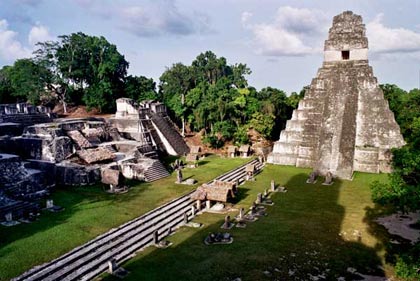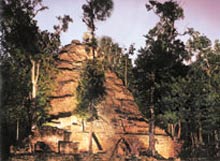Accident of an ancient civilization
Maya culture is always a mystery. But in the end, thanks to the literary research department, the researchers read the carvings of Maya. The secret picture appeared with a glorious era with conflicts, rivalries and power struggles.
Maya civilization is associated with the history of autonomous cities. Although cities no longer exist, but from ruins, researchers also found evidence that the glorious period intertwined with the event. In addition, the vestiges also indicate that the kings in this period were divine.
Evidence shows that in 378, Waka (formed in 1,000 BC - El Peru today) is the place where the first Mayans came to live, there are four main centers, hundreds of buildings and zones. High temples, memorial monuments, and monuments, worship in limestone caves. West of the center of Petén is a lively trade activity of people on the banks of the San Pedro River.

The temple at Tikal, once occupied by the Great Jaguar - revolves from the dense forests of northern Guatemala - still has the splendor of the ancient Mayan cities.Among the largest autonomous cities formed early in Maya, Tikal was the first target of an army invaded from Central Mexico, arriving on 16 January 1778 BC.For the next five centuries, it became a superpower with many alliances with many enemies throughout Maya.(Photo: Lyndonwong)
Food is available throughout Mayan markets like corn, beans, dried chili, and pears. At this time, they knew how to take latex from the sapo tree to make a lake, to take latex from the rubber tree to make the ball play in rituals. Foreign goods also found directions to Waka .
The Maya used jade for sculpture and jewelry, feathers made in the mountains of the south, and in the eastern plateau - the territory of Teotihuacan, they used stones as weapons and metals. making mirrors .

A pyramid called La Iglesia (Church) stands out in the jungle at Cobá, in Yucatán.With a little understanding of this holy place, we will understand the complex development of the place that used to be a city in Maya.Many tourists came here before a large road was built in the 1970s.
A capital with more than 100,000 inhabitants, perhaps this is the largest city in the world at this time. When the population increased, they became more skilled in cultivation and settlement, knew how to create fields, use humus to fertilize the land, set trap deer, raise fish . to survive. They built many palaces with domes and ways of making pottery, sculpting to show off their own artistic style. In particular, the Mayans have profound knowledge of astronomy and create a 365-day accurate calendar - one of the brilliant achievements of this period.
In the 9th century BC, prolonged droughts made the Maya miserable and deforestation caused soil erosion. At this time, the Maya used the monoculture method of plantation, food storage and trade. They also know how to grow crops like corn, beans, squash, and cacao . Maya society has polygamy and families in royal families get married to maintain power.
Many wars, horrific massacres have occurred in Maya history. The victories, instead of being the inspiration for the birth of new monuments and temples, are becoming increasingly dwindling and unable to create imprints. It can be said that the wars have worn out the strength, reduced the population, destroyed the environment along with drought and wasted, which pushed the ancient civilization of Maya to decline and collapse in the 800s. B.C.


The Big Dipper is like the center of the universe with twinkling stars in the darkness of the 'mage house' at Uxmal.The Mayans meticulously follow the movements of the sky and observe to create the correct solar calendar.They also create mystical connections between the earth and the heavens, key events according to a schedule such as wars and sacrifices around the journeys of Venus and Jupiter.
Kabáh, belongs to Yucatán with a unique and elaborate architectural style, associated with a high embankment wall.The most famous monument here is the Masks palace, with more than 260 holy icons, most of which are rain gods to serve rituals for rain.


From the southern slope of Mexico, a poetic position of Palenque, it is possible to mark the west bank of Maya territory.There are many buildings built by Pakal, a seventh century king buried deep in the 'Temple with inscriptions'.On the left may be one of the many buried places of gold and jade in burial services that have yet to be found.
The Warriors temple shows the message of the great power in Chichén Itzá, north of Yucatán - once once prosperous, considered a commercial center for thousands of years, until the southern cities collapsed.The paintings inside the temple show that the goods are transported by road and sea, the blocks outside have a disguised shape with women's headscarfs.
Quynh Tram
- Civilizations of aliens?
- Ancient civilizations were forgotten
- Mysterious ancient civilizations unknown
- The mystery of the first ancient civilization
- Ever had a civilization in Antarctica?
- Discovered ancient civilization never known in India
- Redefining the age of Indian civilization
- Decipher the collapse of the first ancient civilization
- The mark of the suspect is of ancient civilization on Mars
- Uxmal City: Ancient Mayan civilization is still unknown
- Discovery of 10,000-year-old civilization traces on the seabed
- History of dogs and American civilization
 Discovered an ancient centipede fossil 99 million years old
Discovered an ancient centipede fossil 99 million years old Discovered bat-like dinosaurs in China
Discovered bat-like dinosaurs in China Discovered a 200-year-old bronze cannon of the coast
Discovered a 200-year-old bronze cannon of the coast Discover 305 million-year-old spider fossils
Discover 305 million-year-old spider fossils 2,000-year-old Mayan invention could save us
2,000-year-old Mayan invention could save us  Discovering Maya magic medicine that causes hallucinations in the most unexpected place
Discovering Maya magic medicine that causes hallucinations in the most unexpected place  The unexpected grave of the jade-toothed 'queen of Maya'
The unexpected grave of the jade-toothed 'queen of Maya'  How did the ancient Maya give their children unique names?
How did the ancient Maya give their children unique names?  Discover the largest and oldest ritual complex of Maya civilization in Mexico
Discover the largest and oldest ritual complex of Maya civilization in Mexico  Uncover the mystery of the Maya civilization when solving an 800-year-old code to translate ancient books
Uncover the mystery of the Maya civilization when solving an 800-year-old code to translate ancient books 